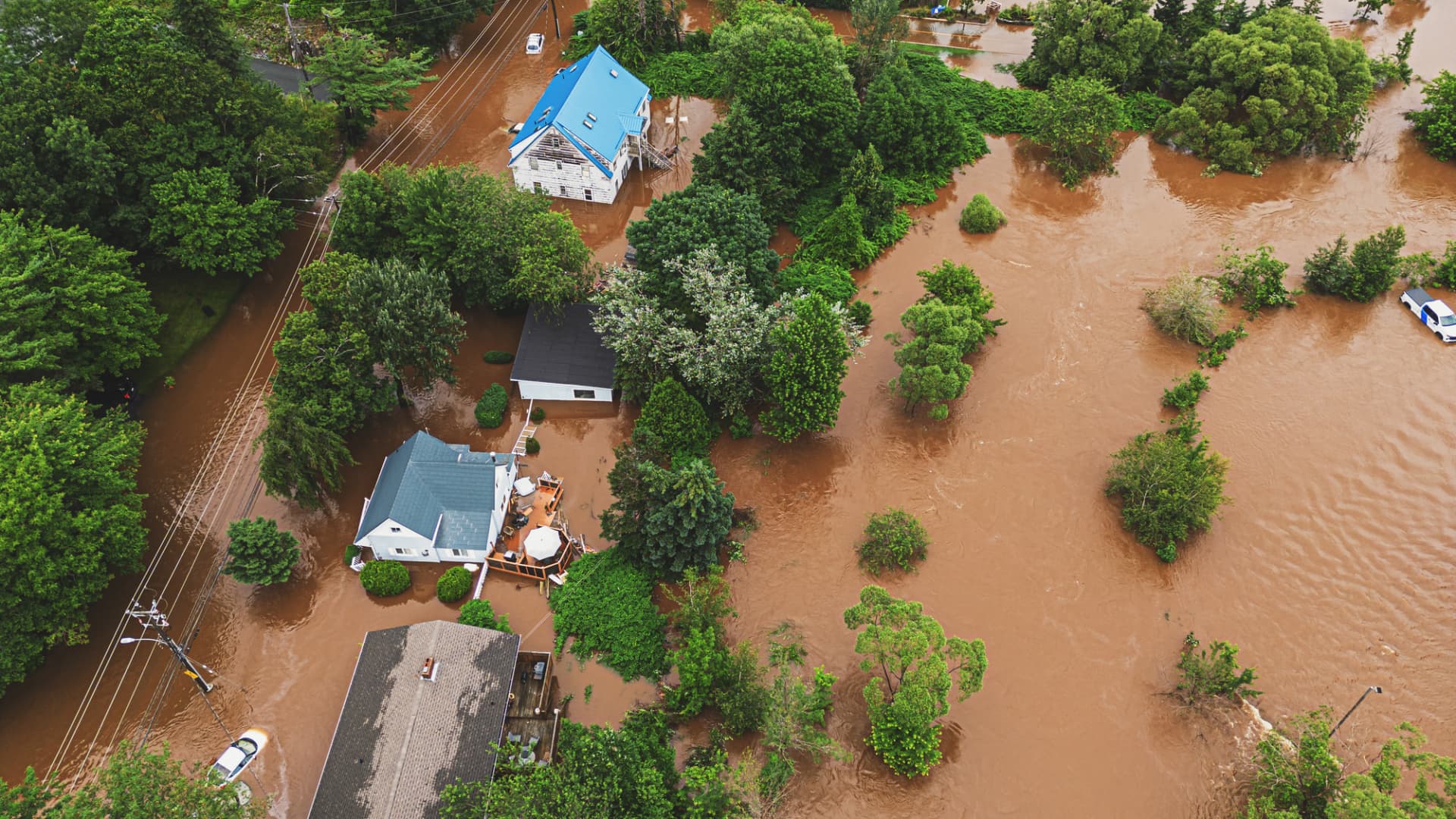Shaunl | E+ | Getty Images
Consumers in the market for a home have been patiently waiting for the Federal Reserve to cut interest rates — a move it seems poised to make in September.
But without action from Congress, there could be another change at the end of that month that makes it temporarily trickier to buy or sell a home in some areas, or to refinance an existing mortgage.
That’s because the National Flood Insurance Program — the government-sponsored public insurance program that is the largest flood insurer in the U.S. — needs to be reauthorized by Sept. 30 to continue to issue new policies or increase coverage on existing policies.
If you are buying or selling a house, you want to avoid the end of September and the beginning of October.
Jaret Seiberg
managing director and financial policy analyst at TD Cowen
Homeowners insurance policies typically don’t cover flood damage, meaning consumers who want to protect their home and its contents from that peril need a stand-alone flood policy. Mortgage lenders may require applicants to obtain such a policy before closing on a home, depending on the flood risk for the property.
“This is about the ability to get a mortgage in a flood zone after Sept. 30,” said Jaret Seiberg, a managing director and financial policy analyst at TD Cowen. “Without an [NFIP] extension, you’re not going to be able to get a mortgage in any area that requires flood insurance.”
More from Personal Finance:
Here’s what’s not covered by flood insurance
How to prevent hurricane damage on your home
People are moving out of cities with poor air quality
Congress established the NFIP in 1968 to provide reasonably priced flood insurance coverage. The Biggert-Waters Flood Insurance Reform Act of 2012, which included the NFIP authorization, expired on Sept. 30, 2017. Since then, Congress has extended the NFIP’s authorization 30 times — but it has also lapsed briefly three times in that period.
“This has been an issue now for many years where the program faces expiration and Congress, [at the] last minute, reauthorizes it,” said Bryan Greene, vice president of policy advocacy at the National Association of Realtors. “We’re trying to prevent natural disasters, but we seem to always face this potential man-made disaster of not acting timely enough.”
What a program lapse would mean for home sales
If the NFIP experiences a lapse in its authority, it will not be able to issue new policies, including for people whose lenders require flood insurance or increase coverage on existing policies (including property owners looking to refinance existing mortgages), according to a spokesperson for the Federal Emergency Management Agency, which operates the NFIP.
It’s possible the home sale transaction would be halted or be held up until the buyer can obtain flood insurance, said Jeremy Porter, head of climate implications research at First Street Foundation, a nonprofit organization in New York that focuses on quantifying the financial risk of climate change. That might entail waiting for Congress to reauthorize the NFIP, or looking for coverage on the private market.
The latter tactic isn’t easy. “There are very few private insurers that offer any type of flood insurance,” said Daniel Schwarcz, a professor of law at the University of Minnesota Law School who focuses on insurance law and regulation.
“There are some very niche types of policies out there … but for all intents and purposes,” he said, the NFIP is “the only available option for flood insurance.”
And if the NFIP lapses, it could make the search for a private insurer more difficult: “If you eliminate that foundation, the rest of the market isn’t there,” said Seiberg.
When the program lapsed from May 31 until July 2 in 2010, 6% of real estate agents reported a delayed or canceled sale, according to a report by the National Association of Realtors. In that report, from 2011, it estimated a one-month NFIP lapse could affect about 40,000 closings.
“If you are buying or selling a house, you want to avoid the end of September and the beginning of October,” said TD Cowen’s Seiberg. “There is no need to take the risk that the flood insurance program will lapse when you could close ahead of Sept. 30.”
How homeowners would be affected by a lapse
The NFIP insures 4.7 million policyholders and protects more than $1.28 trillion in assets. Those existing policyholders may be shielded by the effects of a lapsed NFIP, said Seiberg.
Policies that are in force will remain in force and the NFIP will continue to pay claims under those policies during a lapse, according to the FEMA spokesperson.
If your flood insurance policy’s renewal or expiration date is around Sept. 30, try to renew it early, said Yanjun Liao, an applied microeconomist and fellow at Resources for the Future, a nonprofit research institution in Washington, D.C.
“Check the expiration date and make plans in advance,” said Liao, whose research focuses on natural disaster risk management and climate adaptation.
Homeowners considering refinancing an existing mortgage may also want to weigh the timing with the Sept. 30 reauthorization deadline in mind, if their lender has required flood insurance coverage.
Why NFIP reauthorization is a ‘catch-22’
The NFIP has been continuously reauthorized because of the “potential consequences” of limited private insurers available, Schwarcz said.
“We’re in this real catch-22,” said Schwarcz. “We have a bad program; no one likes it.
“But you can’t get rid of it because people are dependent on it without a better alternative, and no one can agree on better alternatives.”
Critics often point to policy pricing as a concern.
Until recently, the NFIP had a reputation as being a subsidized insurance program, in which people in places far away from the coast paid for flood insurance for those who live in high-risk areas, said First Street Foundation’s Porter.
Then in 2021, FEMA implemented Risk Rating 2.0, a new pricing system that would accurately reflect the cost of an area’s risk. Homeowners and elected representatives of coastal states have pushed back against that change because of how high premiums got.
“All of a sudden, you went from paying $800 a year to paying thousands of dollars a year for your insurance,” Porter said.
Sen. Bill Cassidy, R-La., spoke in early August about the rising costs of NFIP premiums in his Gulf Coast state, and urged Congress to improve the program.
“My team is working on a bipartisan solution that will roll back Risk Rating 2.0, and make flood insurance affordable and accountable again,” said Cassidy in his speech.
Congress is unlikely to let the NFIP entirely expire, given the number of homeowners who depend on the program, Seiberg said.
“The real problem is that the flood insurance program is a financial debacle and Congress doesn’t seem capable of fixing it and, instead, what Capitol Hill does is just kick the can down the road,” he said.


 Blog Post7 days ago
Blog Post7 days ago
 Economics1 week ago
Economics1 week ago
 Finance1 week ago
Finance1 week ago
 Economics1 week ago
Economics1 week ago
 Economics1 week ago
Economics1 week ago
 Finance1 week ago
Finance1 week ago
 Personal Finance1 week ago
Personal Finance1 week ago
 Accounting1 week ago
Accounting1 week ago












